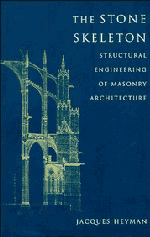2 - Structural Theory of Masonry
Published online by Cambridge University Press: 05 August 2014
Summary
Masonry is an assemblage of stones – or bricks, or indeed sun-dried mud (adobe) – classified for convenience with certain distinct labels, as Byzantine, Romanesque, Gothic, but recognized by engineers as having a common structural action. This action arises directly from the properties of the material.
It is prudent and convenient to regard a masonry building as a collection of dry stones (or bricks etc.), some squared and well fitted, some left unworked, and placed one on another to form a stable structure. Mortar may have been used to fill interstices, but this mortar will have been weak initially, and may have decayed with time – it cannot be assumed to add strength to the construction. Stability of the whole is assured, in fact, by the compaction under gravity of the various elements; a general state of compressive stress exists, but only feeble tensions can be resisted.
All this must have been well understood by medieval cathedral builders, although they would not have had numerical concepts of stress or of the strength of their material. A modern engineer would perhaps make calculations to relate these quantities. In this connexion reference to nineteenth-century practice in the design of great masonry arches is illuminating. An indirect parameter was used to express the strength of stone – the height to which a prismatic column might (theoretically) be built before crushing at its base due to its own weight.
- Type
- Chapter
- Information
- The Stone SkeletonStructural Engineering of Masonry Architecture, pp. 12 - 26Publisher: Cambridge University PressPrint publication year: 1995
- 1
- Cited by



